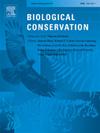海洋保护区的保护效益取决于基因型和表型多样性的知识整合
IF 4.9
1区 环境科学与生态学
Q1 BIODIVERSITY CONSERVATION
引用次数: 0
摘要
保护种内性状变异对于维持物种的生存能力至关重要。它能确保物种适应变暖和日益随机的环境,并在极端事件发生后恢复。在这里,我们研究了挪威峡湾中两种同域但基因不同的大西洋鳕鱼生态型的空间管理对种内遗传和表型变异的选择性影响。我们发现,同域鳕鱼基因型之间的表型差异主要由形态和代谢特征驱动。与沿岸生态型相比,近海鳕鱼在低温条件下的代谢维持成本较高,但在暖适应条件下的有氧能力较低,这表明有氧生理过程受到了热限制,超出了代谢维持的范围。近海鳕鱼的足柄也更大、更粗,身体状况更好。我们发现,Tvedestrand 海洋保护区的禁渔区(NTZ)所带来的保护效益与个体空间利用大小无关,而是来自于生态型在栖息地占用方面的特异性差异。研究结果特别表明,目前划定的禁渔区并不包括沿海和高度栖息的鳕鱼生态型所占据的栖息地,这种生态型表现出更强的代谢热耐受性,但被认为已经处于枯竭状态。我们的研究举例说明了为什么保护种内多样性与旨在减少进一步选择压力(如持续的环境变化)影响的管理实施直接相关。仔细调查种内多样性并将这些知识融入渔业管理和保护区设计中,可以防止不必要的额外选择压力,并有助于为基因型和表型提供广泛的保护。本文章由计算机程序翻译,如有差异,请以英文原文为准。
Conservation benefits of marine reserves depend on knowledge integration of genotypic and phenotypic diversity
Conserving intraspecific trait variation is vital for maintaining the viability of species. It ensures a species to adapt to warming and increasingly stochastic environments, and to recover following extreme events. Here we investigate the selective effects of spatial management on intraspecific genetic and phenotypic variation of two sympatric but genetically distinct Atlantic cod ecotypes in a Norwegian fjord. We found that phenotypic differences between sympatric cod genotypes were mainly driven by morphological and metabolic traits. Offshore cod had higher metabolic maintenance costs at cool temperatures but lower aerobic capacity at warm acclimation than coastal ecotypes, indicative of thermal constraint of aerobic physiological processes beyond metabolic maintenance. Offshore cod also had larger and thicker peduncles and better body condition. We found that protection benefits from the no-take zone (NTZ) of the Tvedestrand marine protected area were independent of individual space-use size, but instead resulted from ecotype-specific differences in habitat occupation. Results specifically show that the current delimitations of the NTZ do not cover habitats occupied by the coastal and highly resident cod ecotype which shows greater metabolic thermal tolerance but is considered to already be in a depleted state. Our study exemplifies why protecting intraspecific diversity is directly relevant for management implementations aimed at reducing the impact of further selection pressures such as ongoing environmental change. Careful investigation of intraspecific diversity and integration of such knowledge to fisheries management and design of protected areas may prevent unwanted additional selective pressures and contribute to offer broad protection to genotypes and phenotypes.
求助全文
通过发布文献求助,成功后即可免费获取论文全文。
去求助
来源期刊

Biological Conservation
环境科学-环境科学
CiteScore
10.20
自引率
3.40%
发文量
295
审稿时长
61 days
期刊介绍:
Biological Conservation is an international leading journal in the discipline of conservation biology. The journal publishes articles spanning a diverse range of fields that contribute to the biological, sociological, and economic dimensions of conservation and natural resource management. The primary aim of Biological Conservation is the publication of high-quality papers that advance the science and practice of conservation, or which demonstrate the application of conservation principles for natural resource management and policy. Therefore it will be of interest to a broad international readership.
 求助内容:
求助内容: 应助结果提醒方式:
应助结果提醒方式:


